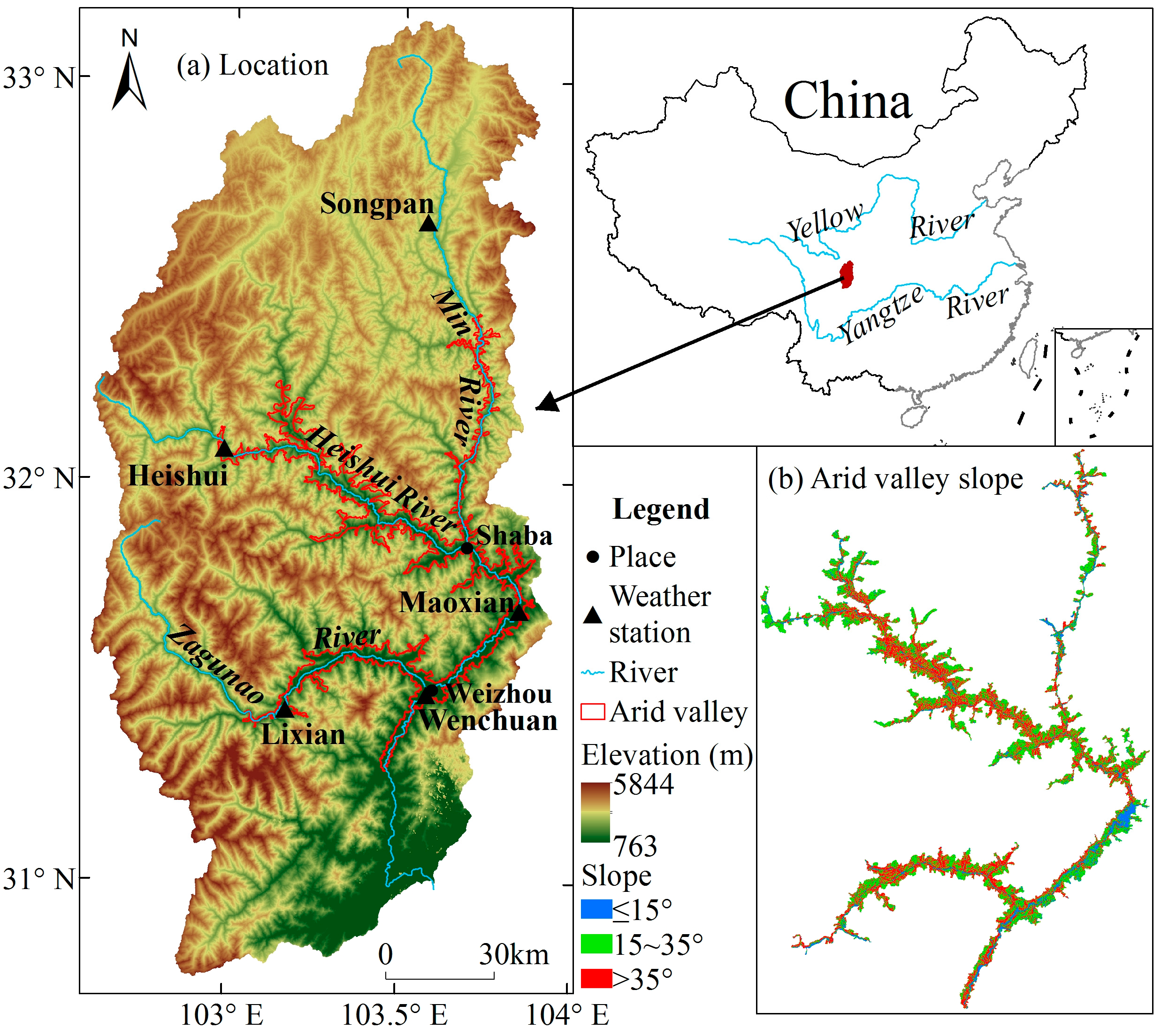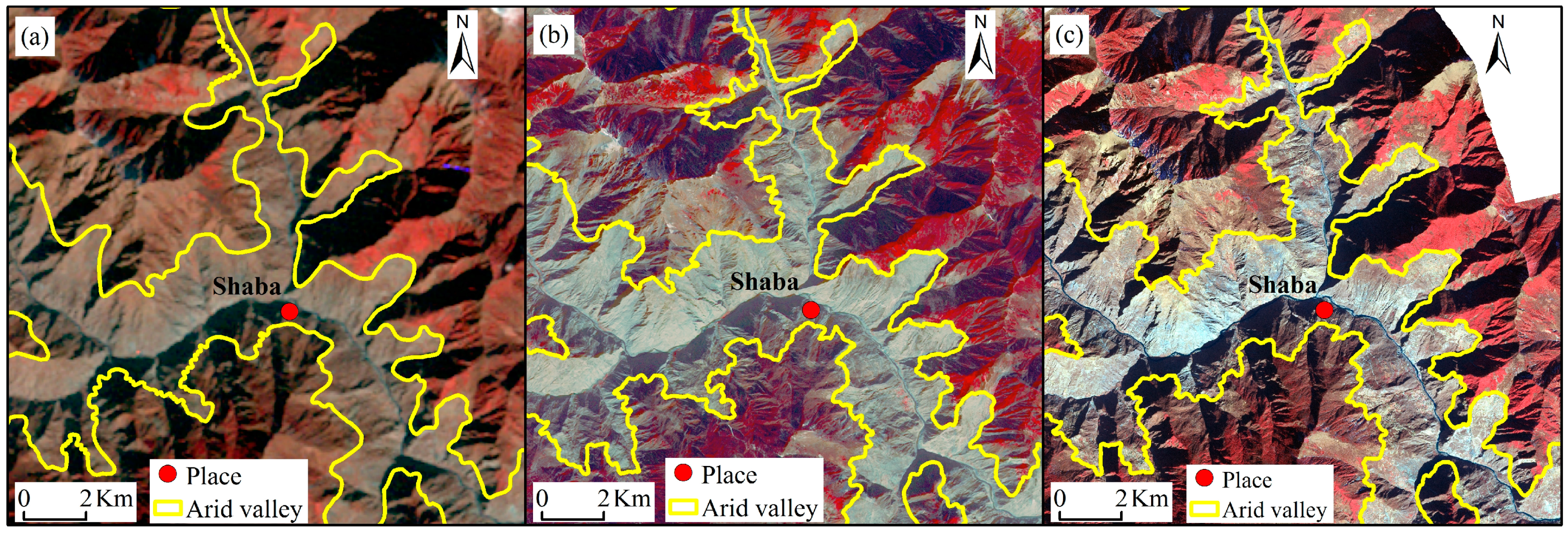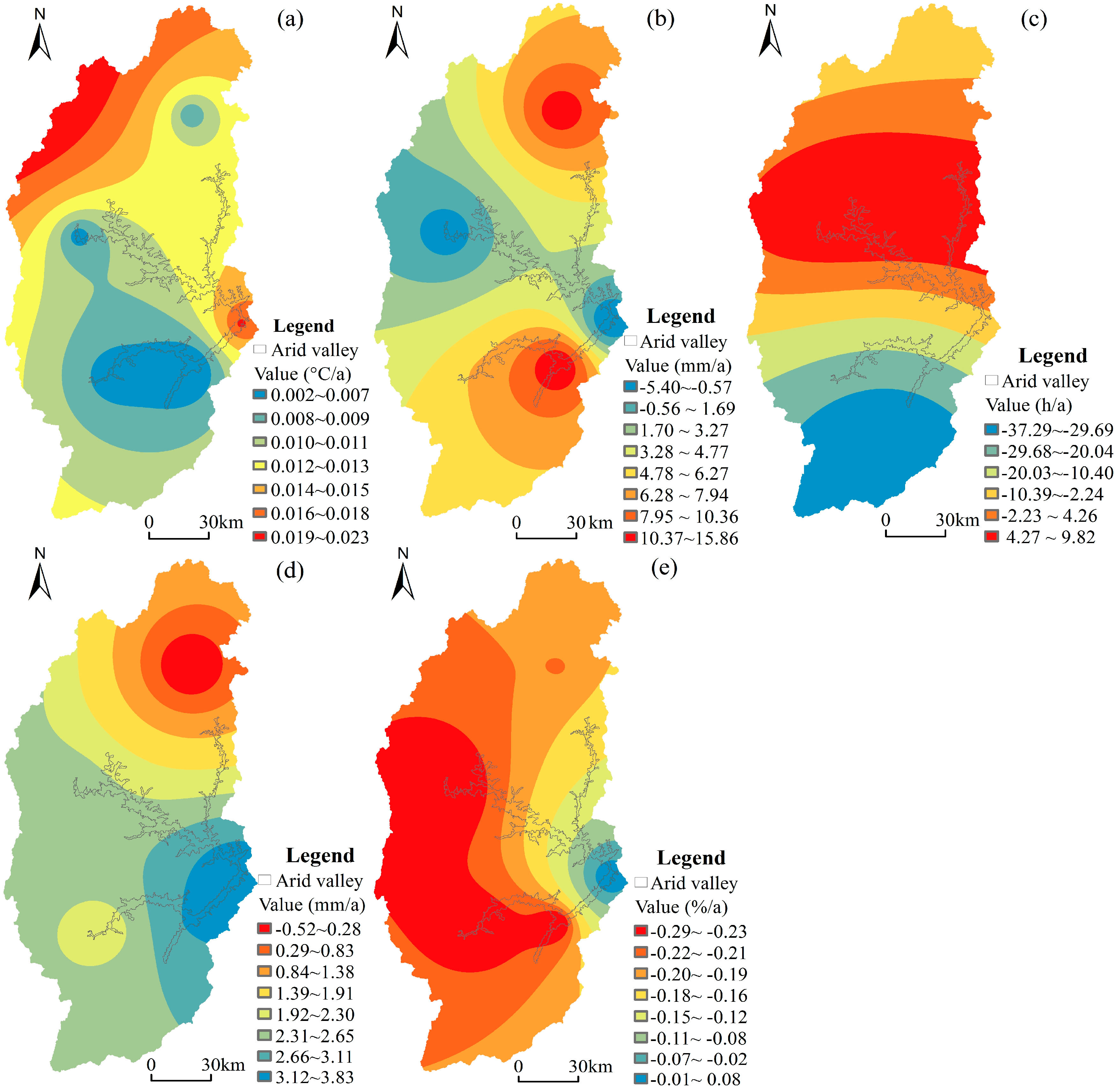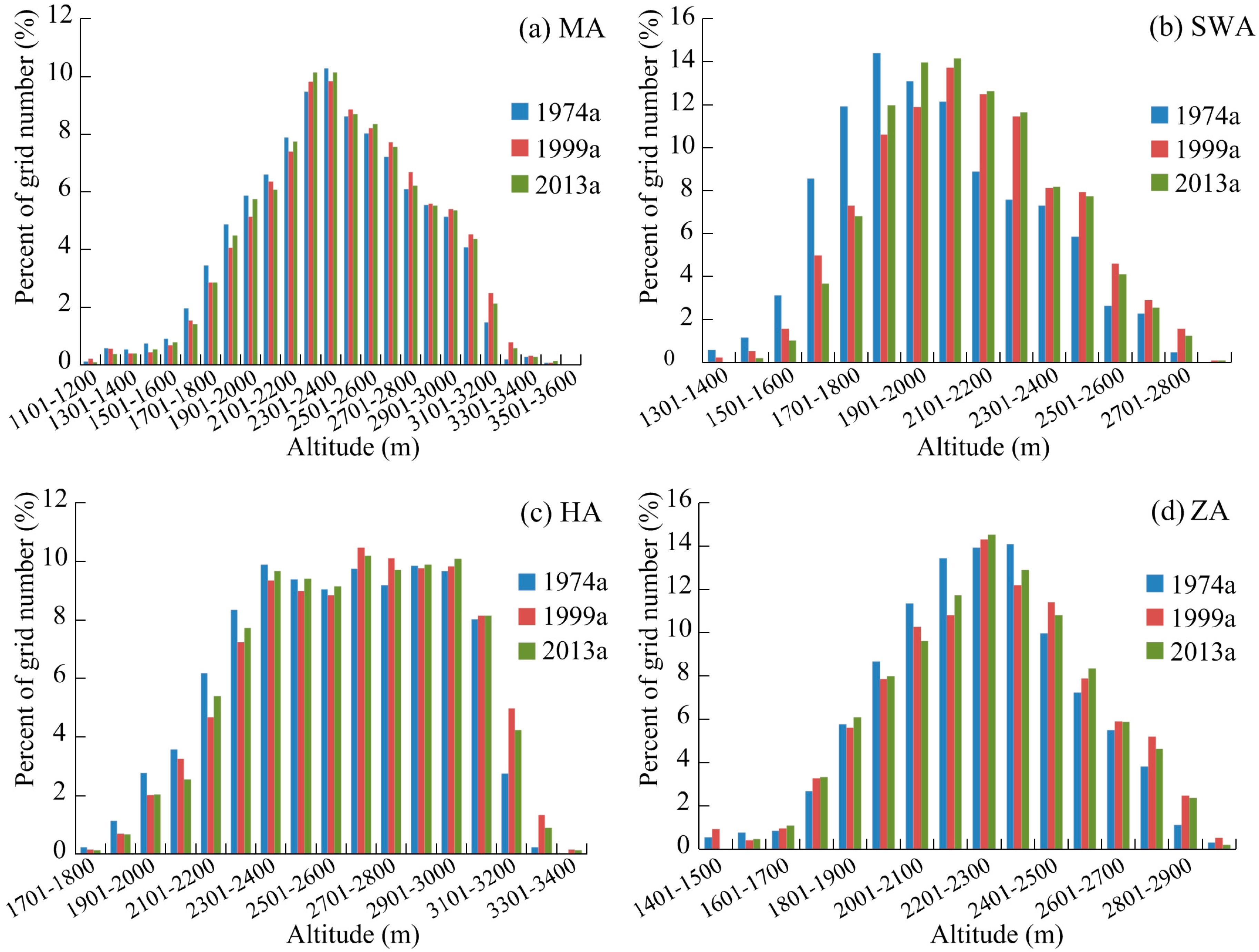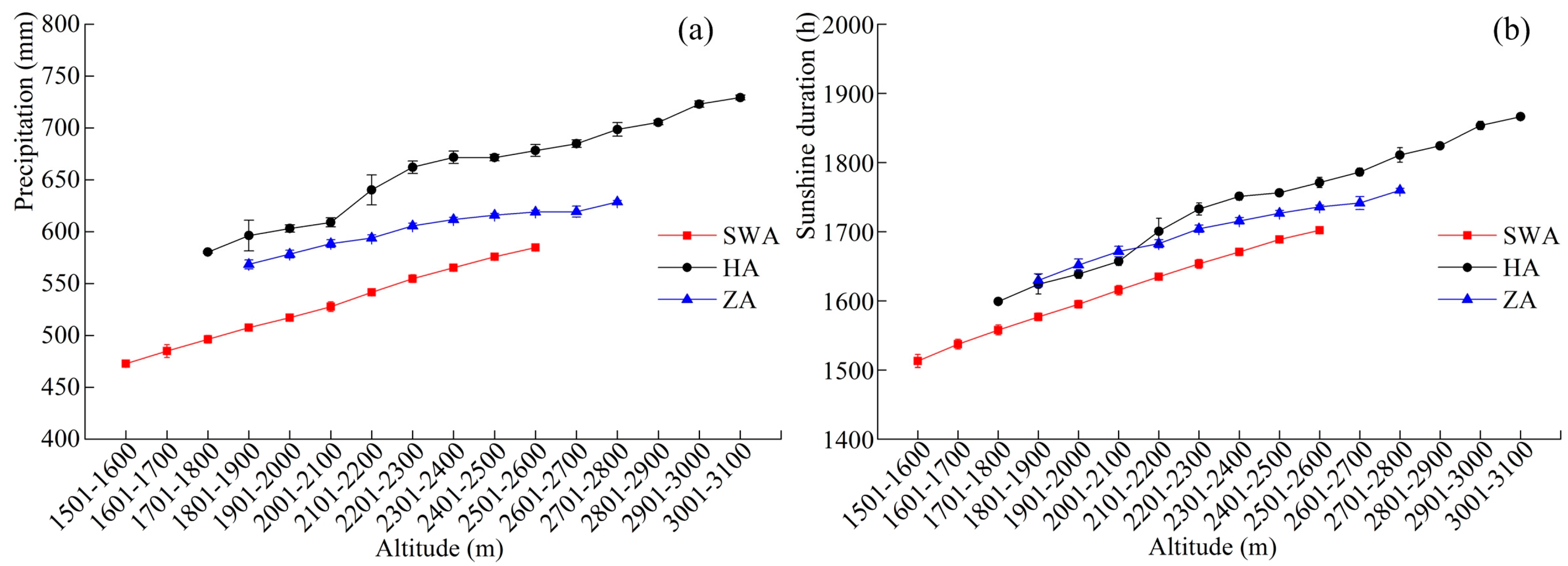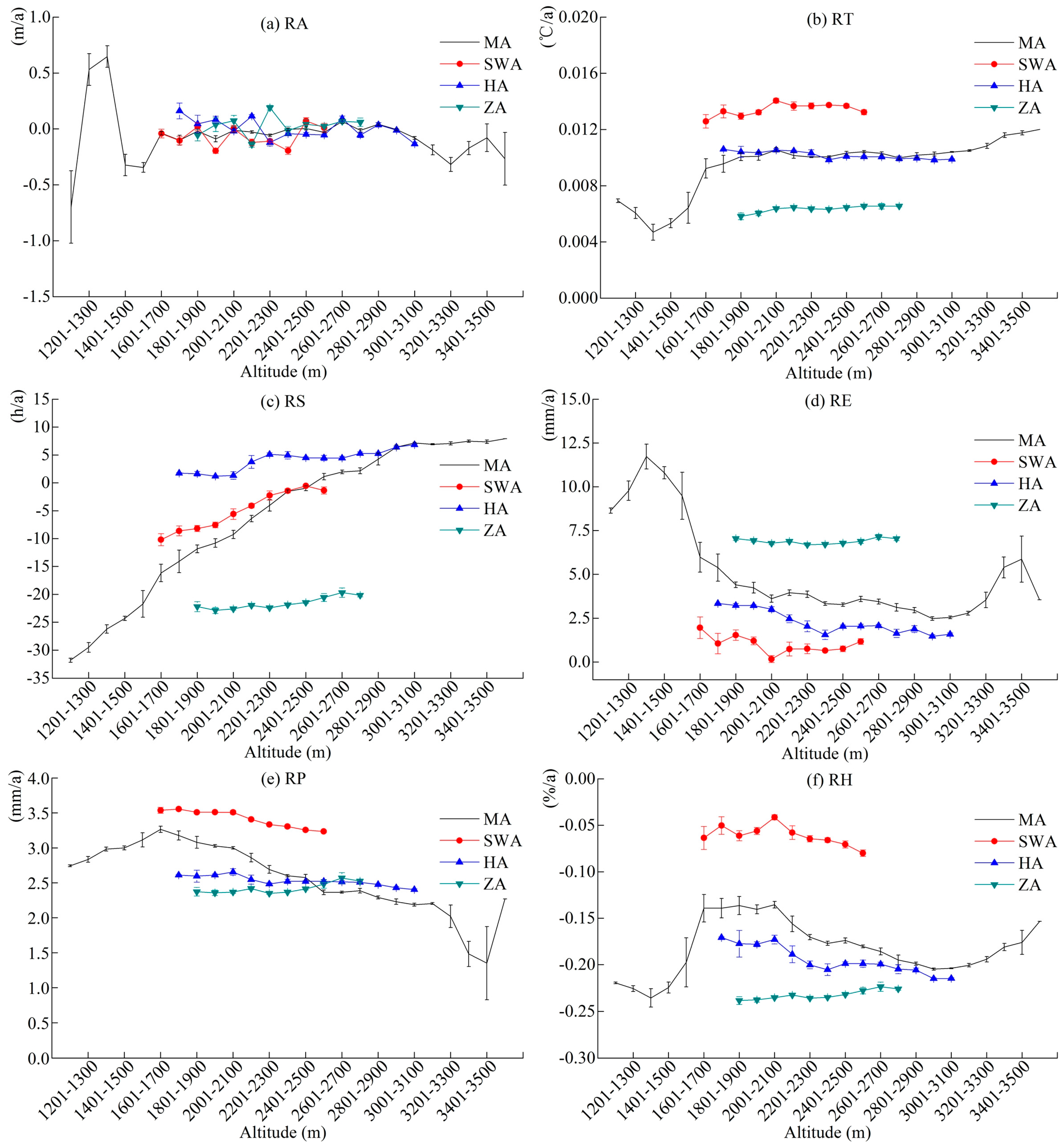1. Introduction
The arid valley is a special geographical and ecological phenomenon in the humid and sub-humid region of China, located at the Hengduan Mountain Area from the Tibetan Plateau to the Sichuan Basin. From the perspective of natural geography, the arid valley is the lower part of the valley, where xerophyte grows and humid vegetation surrounds, associated with certain climate conditions. From the standpoint of socio-economic analysis, the arid valley contains areas with water shortages on farming and conditions having an insufficiency of irrigation. Hence, the arid valley covers three aspects of climate, vegetation, and socio-economy [
1,
2]. At present, there are no common standards for the accurate definition of the arid valley. In earlier studies, the annual dryness between 1.50 and 3.99 were used, defined as the ratio of annual evaporation power and annual precipitation [
2]. With the development of remote sensing and geographic information technology, the arid valley was defined based on the grey white colour shown in TM (Thematic Mapper) images in standard false colour [
3], combined with the classification of vegetation and bare land, the slopes above 25 degrees [
4], annual rainfall of less than 400 mm, and an evaporation coefficient above 2 [
5]. The boundary of the arid valley is located at the ecotone between local drought-tolerant vegetation and mixed evergreen and deciduous, coniferous, and broad leaved mixed forests. As a unique natural geographical line in this particular ecosystem, the arid valley boundary’s structure is characterized with high heterogeneity and strong variability, and the responses of the arid valley boundary to changes in environmental conditions are more sensitive than the adjacent ecosystems [
6]. The fluctuation of the arid valley boundary has to do with the specific performance of the mountain vegetation system to regional environmental changes. Related research can provide a new method for the exploration of regional climate and environment change. Under the background of global warming, the regional response of the mountainous environment to climate change has become one of the hottest scientific issues in current academic research [
6,
7,
8]. It mainly relates to timberline [
9,
10,
11,
12] and snowline [
13,
14,
15], etc., but lacks dynamic analysis on the boundary of the arid valley.
The natural factors and human factors have jointly promoted the formation and development of the arid valley. The former plays a controlling role and human disturbance is only reflected at the superimposed effect in local areas [
16,
17,
18,
19,
20]. First, the alternative arrangement of the deep valley and the high mountain has formed the region’s landscape pattern due to the strong down-cutting of rivers. The atmospheric circulation, foehn effect, and mountain-valley breeze are three important natural drives in the formation of the arid valley. Owing to these influences, the climate in the arid valley is dry and hot in the lower part, and moist and cool in the upper. The regional differentiations of the arid valley and the differences of its drought degree and heat conditions are mainly controlled by the topographical contour, altitude, and relative height. Second, with sufficient heat and light resources, the arid valley has become the core area of regional social and economic activities. Anthropogenic disturbances, such as urban development, village expansion, slope cultivation, cattle grazing, and deforestation, have intensified the expansion of the arid valley, while ecological construction, like the Natural Forest Protection Project and the Green for Grain Project, have promoted the improvement of the local drought landscape. Therefore, climate change and human activities are the main reasons for dynamic changes and regional differentiations at the arid valley boundary.
The arid valley in the upper reaches of the Min River is a typical V-shaped dry-temperate valley in the Hengduan Mountains. The upland-valley is the main landform type in this region. And the relative height of the ridge and valley is between 1500–3000 m (
Figure 1a). In the valley bottom, although the flat land has the disadvantages of small area, scattered distribution, and thin soil layer, the settlements have been concentrated by the rich heat and convenient irrigation. Between the valley bottom and the valley shoulder, the slope is steep (above 35 degrees) because of the strong cutting of the rivers (
Figure 1b). Due to the gentle terrain and the relative balance between water and heat, the arid valley shoulder near the arid valley boundary has become another ideal location for mountain settlements [
2,
21]. The foehn effect in the arid valley of the upper reaches of the Min River is significant and the climate has large fluctuations in the wet and dry seasons. Owing to uneven rainfall and strong evaporation, the droughts of climate and soil are serious and the limiting effect of precipitation is very obvious [
16]. Adapting to the drought environment, the arid shrub that is distributed at 1300–2200 m is the main vegetation type and has the appearances of the xeromorphic community, such as small leaf, hairy, spiny, succulent leaves and deep roots [
22,
23,
24,
25]. Due to the simple and weak stability of the vegetation community structure, the regional ecological environment is highly vulnerable and the arid valley boundary is very unstable [
26,
27]. During 1974–2000, the highest altitude of the arid valley boundary in the upper reaches of the Min River ascended 53 m at the speed of 2 m/a [
3]. Meanwhile, some of the desert species, such as
Convolvulus tragalanthoides and
Nitraria tangutorum, have expanded and become the local dominant species in some areas, indicating an increase in the regional drought degree and the degradation of the ecological environment [
28]. On one hand, due to an increasing population, these changes are closely related to growing deforestation and slope cultivation; and on the other hand, climate warming also has a certain impact [
16,
29,
30,
31,
32]. However, less data is presented to support these conclusions, and the quantitative study on the displacement process of the arid valley boundary under climate change is rarely involved, especially in regard to the analysis in the recent period.
Therefore, this paper revealed the relationship between the arid valley boundary’s displacement and regional climate change during 1999–2013 in the upper reaches of the Min River, seeking a new approach to explore the responding characteristics of the mountain environment to climate change at the watershed scale. Meanwhile, the study can provide important practical value to guide ecological construction and protection in the upper reaches of the Min River.
2. Study Area
The arid valley in the upper reaches of the Min River is located at 31.27° N–32.43° N, 102.94° E–103.90° E, the transition zone from the Tibetan Plateau to the Sichuan Basin, and includes the drought areas of Wenchuan County, Li County, Mao County, Heishui County, and Songpan County in Sichuan Province, China (
Figure 1a). In this region, the ranges of annual average temperature, precipitation, and evaporation are 6.7–14.6 °C, 454–798 mm, and 1300–1450 mm, respectively. Adapting to the vertical climate belt, the mountain vegetation vertical belt shows: small-leafed shrubs in the arid valley (1300–2200 m); deciduous broad-leaved and mixed coniferous broad-leaved forests (2000–2800 m); spruce and fir forests (2800–3600 m); alpine brushes and meadows (>3600 m); and the snow belt (>3900 m) [
20]. The dominant shrub species in the arid valley belong to the temperate genera. They include the
Convolvulus tragacanthoides,
Ajania achilleoides,
Aster smithianus,
Artemisia gmelinii, etc. [
25], and the main soil types developing under the shrubs are the yellow cinnamon soil and cinnamon soil. As the typical fragile ecological-environment zone in the upper reaches of the Yangtze River, the arid valley is characterized by a low threshold on ecological security, but is high risk in ecological degradation, with poor habitat suitability, frequent geological disasters (earthquake, landslide, debris flow, etc.), and strong human activities [
26,
33]. Ecological restoration and reconstruction in the arid valley has become an important aspect of current academic research and government work [
17,
34].
